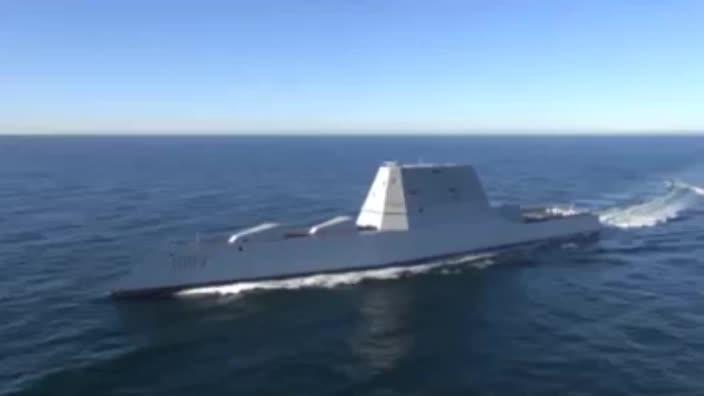US Zumwalt stealth destroyers may lose their guns
It’s a disaster for the world’s most expensive warship. It’s sleek, stealthy and full of secrets. But the US navy may be forced to pull its teeth.

The Zumwalt-class destroyers of the US Navy are a marvel of modern engineering. Their smooth, stark lines are optimised for stealth. Everything inside is as automated as it can be. And along with its secret array of radars and missiles are incredible new cannons: but not for long.
Only three Zumwalt-class destroyers have been built. The project proved too costly for a full production run of 30.
Now costs are crippling the ships themselves.
Dubbed the Advanced Gun System (AGS), it works fine — which is somewhat unusual in itself when put alongside other advanced technologies such as the aircraft carrier USS Ford’s electromagnetic catapult, arresting wires and bomb hoists.
It’s just that the gun’s ammunition is too expensive to shoot.
Each destroyer carries two 155mm AGS guns — tucked away neatly in the angular containers behind the ship’s bow.
They’re supposed to fire Long-Range Land-Attack Projectiles (LRLAP)s, developed by Lockheed Martin, to be ultra-long range, guided warheads.
Turns out, their range isn’t really all that great after all — and the cost of each shell makes it cheaper to fire off a bulkier missile.

OFF TARGET
Each LEAP shell costs about $US1 million ($A1.37 million). At that price, the Pentagon shut down the production line several years ago.
As a result, there are no shells stored in armouries or aboard ship to be fired.
But the gun itself continued to be fitted to the new destroyers.
The US Navy has reportedly been exploring options of having a new, cheaper, shell designed to suit the guns. But this will take time, resulting in the ships having to sit idle in dock for years to come.
RELATED: What we know about China’s new aircraft carriers
The gun was intended have a 130km range. The range it achieved remains classified.
The challenges the new weapon faces, by the sounds of it, are almost insurmountable: “(this is) a science and technology challenge, not an engineering problem. We just cannot get the thing to fly as far as we want.”
So, the US Navy is considering whether or not to simply rip them out.

“We determined that the best future for that ship is to get it out there with the capability that it has and separate out the Advanced Gun System, leaving everything else in place,” Vice Admiral William R. Merz testified before the Senate Armed Services Seapower subcommittee.
RELATED: Can Australia’s new frigates put up a fight?
“It is a very capable platform with or without that gun. We will be developing either the round that goes with that gun or what we are going to do with that space if we decide to remove that gun in the future.”
But even that capability is being questioned.
Further cost-saving exercises may be damaging its stealth, analysts say.
It was intended to look no bigger than a small fishing boat to existing radars and sensors.
That was achieved through the use of composite materials and sleek, smooth lines.
Those lines are now clearly being disrupted by new equipment simply being bolted to the exterior to save costs.

COURSE CORRECTION
The Zumwalt-class destroyers was conceived in the early 2000s as a land-attack platform to meet a ground-support role identified by the first and second Iraq wars.
Stealth would mean the ship could get close inshore, unseen.
Multitudes of missiles meant the ship could fight off swarms of incoming aircraft.
The precision-guided cannons were supposed to be its primary weapon, capable striking targets deep inland.
RELATED: The US Air Force reveals its vision of the future
Now, that need is no longer so great, Vice Admiral Merz said.
“As a result, the three Zumwalts have been “remissioned to a strike platform, whether sea targets or land targets. It takes advantage of its tremendous arsenal of (vertical launching system) cells. Those VLS cells are larger than any other surface ship VLS cells so that opens up an aperture of more weapons options for that ship.”
Those 80 M54 Verltical Launch System cells will now have to carry a different mix of anti-air and anti-surface missiles to cover the capability gap left by the removal of the gun.
Without the guns, the Zumwalt — apart from its stealth and sensors — comes out wanting.
Older Arleigh Burke-class destroyers have 96 cells, and Ticonderoga-class cruisers 122.
Admiral Mertz said the design had a suitable balance of space, weight and electrical power to carry future ‘directed energy’ weapons — such as lasers. But these had not yet been developed to the point of being mission-ready.
“She is going to be a candidate for any advanced weapon system that we develop,” Admiral Mertz said.



